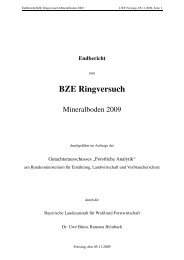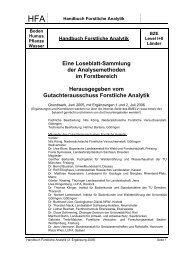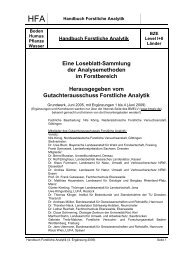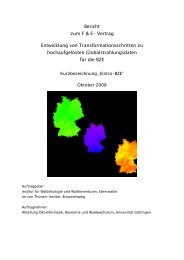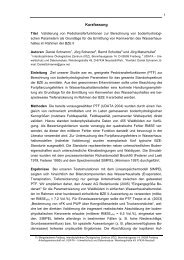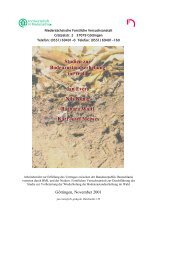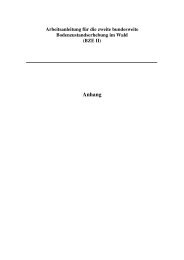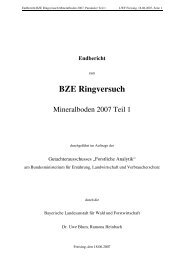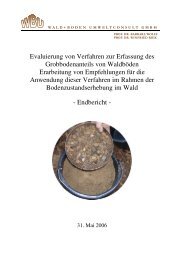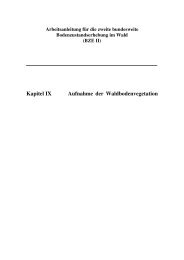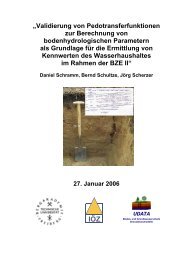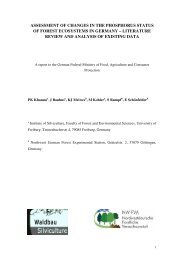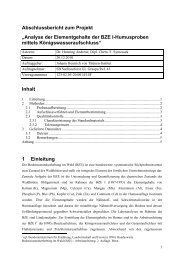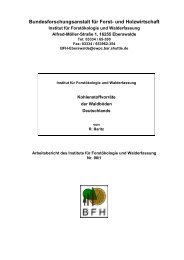assessment of changes in the phosphorus status of forest ...
assessment of changes in the phosphorus status of forest ...
assessment of changes in the phosphorus status of forest ...
You also want an ePaper? Increase the reach of your titles
YUMPU automatically turns print PDFs into web optimized ePapers that Google loves.
or Fe-oxide impregnated paper (Menon et al. 1989, Chardon 2000) have also been<br />
used as a P-s<strong>in</strong>k to determ<strong>in</strong>e available P <strong>in</strong> a wide range <strong>of</strong> soils.<br />
Given <strong>the</strong> wide range <strong>of</strong> methods to test for different P fractions <strong>in</strong> soils, it is very<br />
important to select <strong>the</strong> right test for specific soils and target fractions. The soil<br />
properties affect<strong>in</strong>g selection <strong>of</strong> <strong>the</strong> appropriate P test and recommended methods are<br />
outl<strong>in</strong>ed <strong>in</strong> <strong>the</strong> Table 9.<br />
Da Silva and Van Raij (1999) reviewed different methods <strong>of</strong> measur<strong>in</strong>g <strong>the</strong> available<br />
P content <strong>in</strong> agricultural soils. The methods considered were: anion exchange res<strong>in</strong>,<br />
Olsen, Bray 1, Bray 2, Mehlich 1, Troug, Egner, water, 0,01M CaCl2, iron hydroxide<br />
impregnated filter paper (Pi) and <strong>the</strong> determ<strong>in</strong>ations <strong>of</strong> <strong>the</strong> E and L values. Details<br />
about <strong>the</strong>se methods are given by Kuo (1996). Average values <strong>of</strong> <strong>the</strong> goodness <strong>of</strong> fit<br />
for regressions between <strong>the</strong> soil test method and P uptake <strong>of</strong> plants and correspond<strong>in</strong>g<br />
numbers <strong>of</strong> articles (<strong>in</strong> brackets) <strong>in</strong> which <strong>the</strong> method was considered were obta<strong>in</strong>ed,<br />
showed <strong>the</strong> follow<strong>in</strong>g descend<strong>in</strong>g order: res<strong>in</strong>, 70% (34); E value, 68%(16); L value,<br />
65% (8); Olsen, 54% (48); Bray 1, 50% (42); Mehlich 1,46% (25); Egner, 44% (9);<br />
Bray 2, 42% (19); Water, 42% (15); Truog, 38% (13); CaCl3, 36% (13), and Morgan,<br />
32% ( 13). The results show that <strong>the</strong> anion exchange res<strong>in</strong> method was superior to<br />
o<strong>the</strong>r methods. It has <strong>the</strong> additional advantage that it can be used for both acid and<br />
alkal<strong>in</strong>e soils, has probably <strong>the</strong> best <strong>the</strong>oretical basis, and does not overestimate <strong>the</strong><br />
amount <strong>of</strong> available P as may be <strong>the</strong> case when <strong>in</strong>soluble P forms get dissolved by<br />
acids extractants.<br />
Neyroud and Lischer (2003) compared <strong>the</strong> methods used for soil P availability across<br />
Europe which <strong>in</strong>volved 16 different methods on 135 soils from 12 countries. Each<br />
European country was us<strong>in</strong>g its own method for <strong>the</strong> determ<strong>in</strong>ation <strong>of</strong> <strong>phosphorus</strong><br />
availability to plants, toge<strong>the</strong>r with an appropriate <strong>in</strong>terpretation scheme <strong>of</strong> <strong>the</strong> P<br />
<strong>status</strong> and fertilizer recommendations. The amount <strong>of</strong> extracted P decreased <strong>in</strong> <strong>the</strong><br />
order Ptotal > Poxal. > PAL > PMe3 > PBray > PAAEDTA, PDL, PCAL > POlsen > Ppaper strip,<br />
PAAAc, PMorgan > PH2O, PCO2, PCaCl2. Isotopically exchangeable P was also measured.<br />
Even though all <strong>the</strong> methods reacted <strong>in</strong> <strong>the</strong> same way to <strong>in</strong>creas<strong>in</strong>g amounts <strong>of</strong> added<br />
P <strong>in</strong> several trials, <strong>the</strong>re were wide differences between results obta<strong>in</strong>ed with different<br />
methods. The <strong>in</strong>terpretation schemes for P <strong>status</strong> suggested that about 50 % <strong>of</strong> <strong>the</strong><br />
tested soils were P-deficient.<br />
Sibbesen (1983) ranked different P-tests on <strong>the</strong> basis <strong>of</strong> data from 29 published papers<br />
<strong>in</strong>to three groups: best group: anion-exchange res<strong>in</strong> method; <strong>in</strong>termediate group:<br />
62



